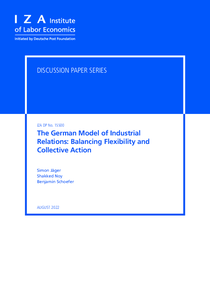The German Model of industrial relations: Balancing flexibility and collective action

Jäger, Simon ; Noy, Shakked ; Schoefer, Benjamin
Institute of Labor Economics, Bonn
IZA - Bonn
2022
37 p.
trade union ; collective bargaining ; code of conduct ; labour relations
Discussion Paper
15500
Labour relations
English
Bibliogr.
"We give an overview of the "German model" of industrial relations. We organize our review by focusing on the two pillars of the model: sectoral collective bargaining and firm-level codetermination. Relative to the United States, Germany outsources collective bargaining to the sectoral level, resulting in higher coverage and the avoidance of firm-level distributional conflict. Relative to other European countries, Germany makes it easy for employers to avoid coverage or use flexibility provisions to deviate downwards from collective agreements. The greater flexibility of the German system may reduce unemployment, but may also erode bargaining coverage and increase inequality. Meanwhile, firm-level codetermination through worker board representation and works councils creates cooperative dialogue between employers and workers. Board representation has few direct impacts owing to worker representatives' minority vote share, but works councils, which hold a range of substantive powers, may be more impactful. Overall, the German model highlights tensions between efficiency-enhancing flexibility and equity-enhancing collective action."
Digital
The ETUI is co-funded by the European Union. Views and opinions expressed are however those of the author(s) only and do not necessarily reflect those of the European Union or the ETUI.